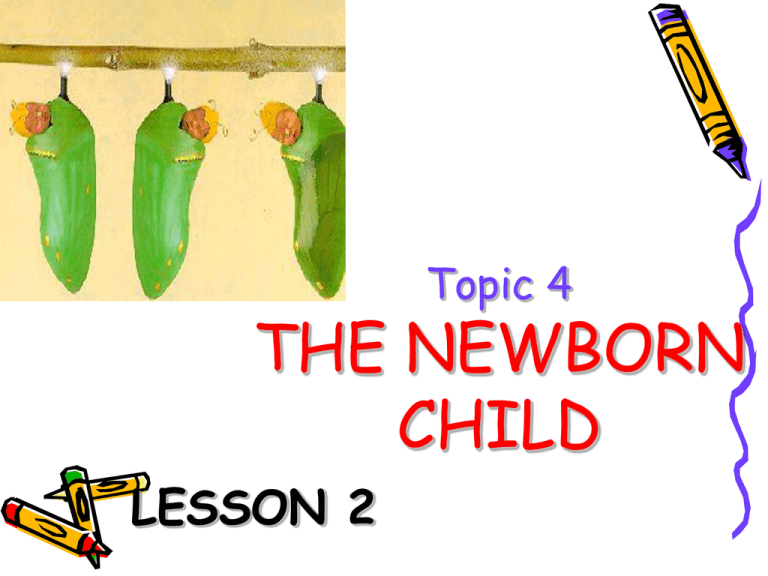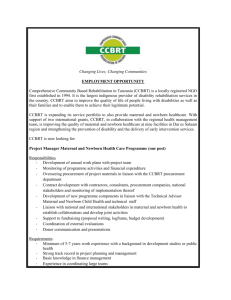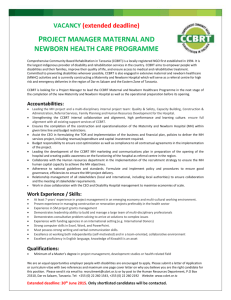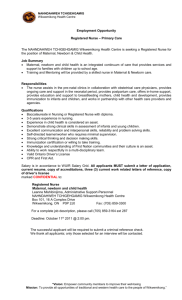Topic 4 The newborn child
advertisement

Topic 4 THE NEWBORN CHILD LESSON 2 Terms: Perinatal Intra natal Neonatal newborn Prenatal Classification of newborn by weight and gestational age • Help in predict potential problems – LBW: <2500gm – VLBW: <1500gm – ELBW: <1000gm • Term :completed 37 weeks gestation till 40 week • Premature; less than 37 weeks gestation • After term: 40-42 week Apgar Score • Originally proposed as a predictor for newborns at risk for complications for bad outcomes (cerebral palsy) • Outcomes – If the Apgar score at twenty minutes after delivery is less than five, there is still only a 20% chance of a handicapping condition. Level of evidence (LOE) 5 Apgar Score Score 0 1 2 Heart Rate Absent <100 >100 Respiratory Effort Absent, irregular Slow, crying Good Muscle Tone Limp Some flexion of Active motion extremities Reflex irritability (nose suctioning) No response Grimace Cough or sneeze Color Blue, pale Acrocyanosis Completely pink Scoring at 1 and 5 minutes of age Additional scoring could be continued at 5 minute intervals if needed. Apgar V. Anesth Analg 1953; 32:260. METHODS OF HEAT LOSS • Evaporation eg wet with amniotic fluid • Convection- e.g. removed from incubator • Radiation- e.g. placing cold objects near incubator • Conduction-e.g. cold stethoscope DESCRIBE FUNCTIONAL ABILITIES OF THE NEWBORN GASTROINTESTINAL TRACT AND LIVER • By birth the newborn has experienced swallowing, gastric emptying, and propulsion • Meconium is formed in utero • Newborn passes meconium witin 48 hours Assessment of the Newborn • Newborn Care In The Delivery Room – Maternal history/labor data – Apgar Scoring – Brief physical exam – Nursing Interventions ACROCYANOSIS GESTATIONAL AGE ASSESSMENT • Two parts – External physical characteristics – Neurological characteristics Maternal conditions, such as pre eclampsia, diabetes, and maternal analgesics and anesthesia may impact certain components of gestational assessment COMPARISON OF CEPHALHEMATOMA AND CAPUT SUCCEDANEUM • CEPHALHEMATOMA –is a collection of blood resulting from ruptures blood vessels between the surface of a cranial bone and the periosteal membrane. They may be bilateral or unilateral and do not cross the suture lines • CAPUT SUCCEDANEUM is a localized, easily identifiable, soft area of the scalp, generally resulting from a long and difficult labor or vacuum extraction. Cephalohematoma Caput Examination precaution • • • • Hand washing Thermal environment Light and noise 5-10 minutes examination time Important History points in caring of newborn • Maternal diabetes – Metabolic and congenital defect • Polyhydramnios – Swallowing defect, GI obstruction • Oligohydramnios – Renal disease, pulmonary hypoplasia • Maternal age – Old age and chromosomal • IUGR • family history Important History points in caring of newborn • Rupture of membrane – sepsis • Delivery type – c/s and TTN • Prenatal care • Maternal blood group – ABO, Rh disease • Infection risk – Maternal Hepatitis carrier – Maternal GBS colonization Physical Eamination • Vital signs – RR 40-60 – HR 120-160 – Temperature axilary 35.5-37.5 • Over bundling • Heater Physical Examination • skin – – – – Pink is normal Acro cyanosis is normal Cyanosis Jaunduce • 1st 24 hours • Cephalopedal distribution – Pale and grayish color in anemia and acidosis respectively – Common skin rash • Erythema toxicum, mongolian spot, General inspection • Flexion of upper and lower extremities • Cortical thumb • Asymetric movement – Brachial plexus and fractured humerous • Ventral, vertical suspension and head control for tone assessment General inspection • Symmetry of the mouth and face – Facial nerve • Vigorous cry is assuring • Weak cry – sepsis, asphyxia,metabolic, narcotic use • Hoarseness – Hypocalcemia, airway injury • High pitch cry – CNS causes, kernicterus Congenital anomalies • Facial gestalt; overall look of facial features that give impression of diagnosis ie: Down syndrome • Minor anomaly: common and no effect on organ function such as simian crease or ear tag • Major anomaly: less common and involve main organ dysfunction like neural tube defect, multicystic dysplastic, kidney Head • Forceps and vaccum marks • Caput succedaneum – Boggy edema in presenting part of head – Cross suture lines – Disapear in few days • Cephalhematoma – Subperiosteal – Weeks to resolve – Dose not cross sutures head • • • • • • Head cicumference Molding Brachycephaly: flat occiput Widening of suture Fontanelles Head auscultation: bruits Ears, Nose, Mouth • Low set ears?,Preauricular pits, External meatus tie • Natal teath • Choanal atresia • Epstein pearls • Cleft, submucosal Neck and clavicle • Webbing; turner syndrome • Excess skin at base of neck posterior in Down syndrome • Goiter • Fracture in clavicle – Asymmetric moro reflex Respiratory • Tachypnea • Nasal flaring • Respiratory effort – Mild retraction • Grunting • asymetric chest rise • supra-sternal, intercostal, subcostal retraction Chest, back • • • • Pectus excavatum Pectus carinatum Suprmammary nipple Breast hpertrophy – Milk production – No redness • Back – abnormal curvature – Sinus trsct, tuft of hair, MMC… Respiratory • Inspection is the key – No grunting, flaring. Retraction • Auscultate – Air entry, symmetry – Early crepitation sound is transmitted upper sound – Late inspiratory crepitation Cardiovascular • • • • • HR 100-160 beats/min Color, perfusion Central cyanosis Single S1 Splited S2 – No split ;single ventricle, pulmonary hypertension Abdomen • Inspection – Scaphoid – Distention – Abdominal wall defect (gastroschisis) • Palpation; – – – – baby sucking and use warm hands Kidneys are normaly palpable Liver 2-3 cm Spleen palpable Umblical vessels • 2 artery, one vein – Hernias ; umbilical and inguinal Genitalia and anus • Penile size • Hypospadias, epispadias • Testes – 2% crypoorchid – Hydrocele • Premature – – – – Prminent clitoris and minora Vaginal skin tag Vaginal discharge /blood Labial fusion Extremities • Erb’s palsy: extended arm and internal rotation with limited movement • Humerous fracture • Digital abnormality – Syndactaly, brachdactaly, polydactaly • Single palmar crease • Hip dislocation – Female, breach CNS • • • • • • • Awakenes and alertness moving extremities Flexed body posture Minimal Head lag Ventral suspension Vertical suspension Moro reflex Neuromuscular Maturity • • • • • • Posture Square window Arm recoil Poplitteal angle Scarf sign Heel to ear Physical Maturity, with maturity • Skin: thicker , less translucent, dry, peeling • Lanugo: • • • • • – fine non pigmented hair all over 27-28 wks – disappears gradually Plantar surface: presence or absence of creases Breast: areola development Ear cartilage Eyelid opening External genitalia – Rugation, desend – Prominent labia majora Condition Hyperventilation Physiological erythema Toxical erythema Physiological jaundice Hyperthermia Physiological weight loss Physiological oliguria Albuminuria Urea crystalluria Sex crisis Disbacteriosis Time of appearance Time of disappearance At birth On the 3rd-5th day of life 2nd-3rd day of life By the end of the 1st week On the 2nd -5th day of life On the 3rd - 4th day By the end of the 1st week The 7th-10th day On the 3rd - 5"1 day On the 2nd -3rd day By the end of the 2nd week By the end of the Is' week At birth The 3rd day At birth On the 3rd-4m day On the 3rd - 4th day The first week The 3rd day By the end of the 2nd week By the end of the 1st week By the end of the 2nd week







